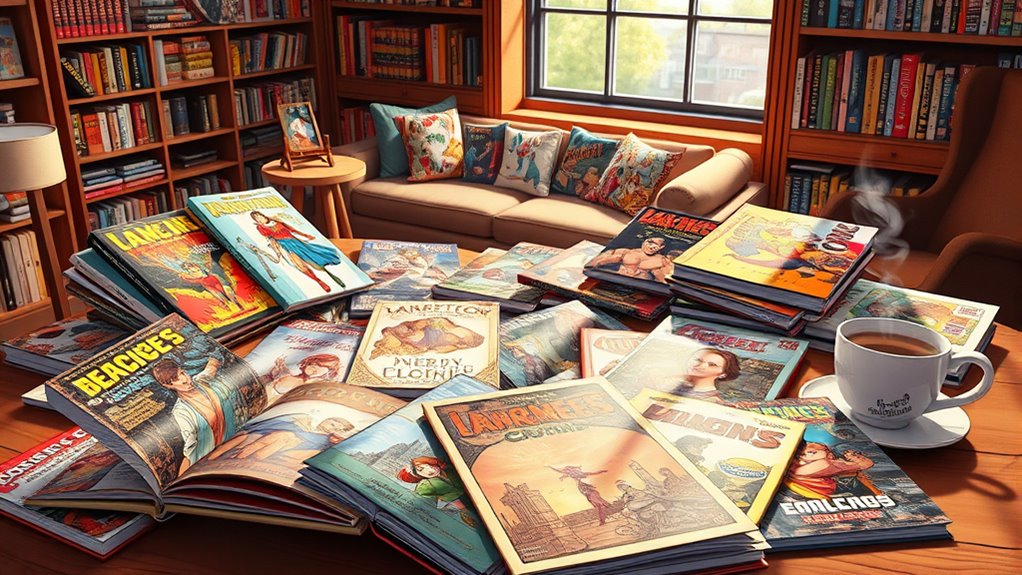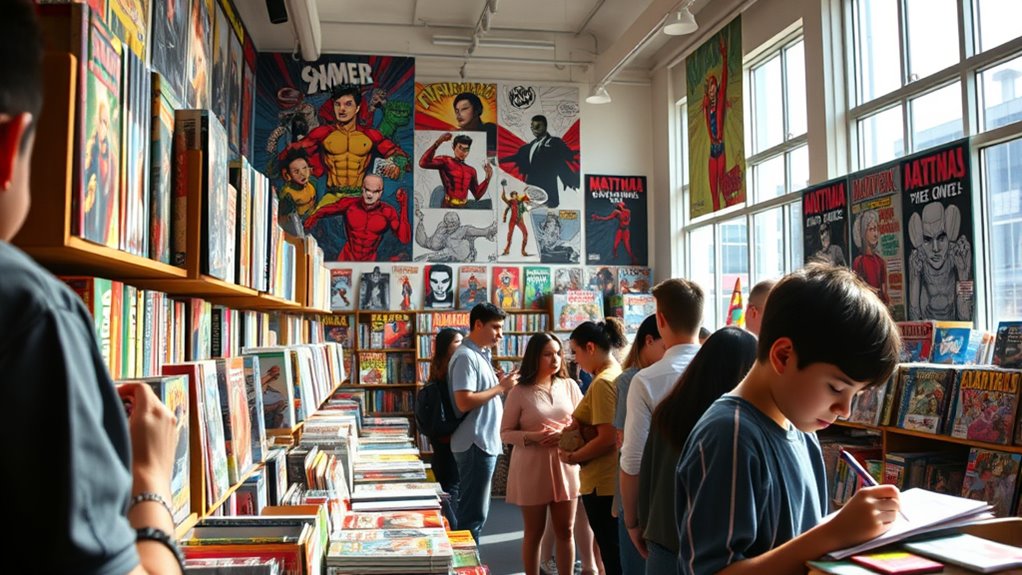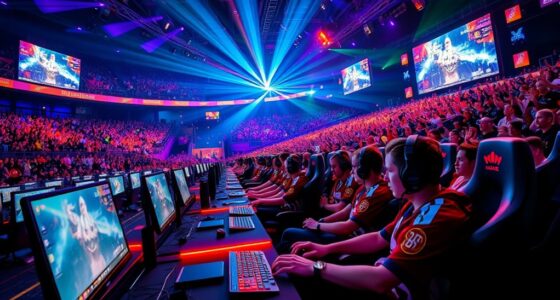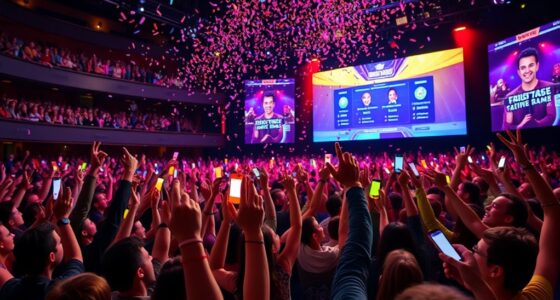Comics and graphic novels have surged in popularity, evolving into a rich storytelling medium that mirrors our culture. You can see this resurgence in the diversity of narratives, from superhero tales to personal stories that address social justice and identity. Their engaging visuals make complex ideas more accessible, drawing in reluctant readers. As they continue to grow on digital platforms, they amplify diverse voices and become even more influential. There’s more to explore about their impact and future potential.
Key Takeaways
- The resurgence of comics and graphic novels is marked by innovative storytelling that pushes boundaries across genres and themes, appealing to a broader audience.
- Modern creators focus on personal narratives, social justice, and cultural identity, reflecting contemporary societal issues and diverse experiences.
- Digital platforms enhance accessibility, allowing readers to engage with comics on their devices and fostering discussions among diverse communities.
- Comics are increasingly recognized in educational settings, effectively teaching complex concepts and engaging reluctant readers through visual storytelling.
- As a dynamic cultural medium, comics continue to evolve, democratizing storytelling and amplifying diverse voices in literature and art.

Have you ever wondered how comics and graphic novels have evolved from simple illustrations to a diverse and powerful storytelling medium? It’s fascinating to see how they’ve transformed over the years. Once considered mere entertainment for children, these art forms now tackle complex themes and resonate with readers of all ages. You can trace this evolution back to the early 20th century when comic strips began appearing in newspapers. These snippets of humor and adventure captured the public’s imagination, setting the stage for the rich, multi-layered narratives we enjoy today.
Comics have evolved from simple childlike illustrations to a profound storytelling medium, captivating readers with complex themes across generations.
As you dive deeper into this world, you’ll notice that the introduction of superhero comics in the 1930s marked a significant turning point. Characters like Superman and Batman not only entertained but also embodied societal ideals and values. You might find it interesting how these heroes reflected the struggles of their times, from the Great Depression to World War II. As you read these stories, you can see that they serve as mirrors, reflecting the hopes and fears of society.
Fast forward to the late 20th and early 21st centuries, and you’ll see a resurgence of interest in comics and graphic novels. This revival has been fueled by a new generation of creators who push boundaries and explore diverse genres. You might enjoy discovering works that focus on personal narratives, social justice, and cultural identity. These stories often challenge traditional conventions and invite readers to engage in meaningful dialogue. The importance of color accuracy in visual storytelling is also becoming more recognized, enhancing the overall impact of graphic novels.
The impact of comics and graphic novels extends beyond entertainment; they’re now recognized as legitimate forms of literature and art. Schools and universities have incorporated them into curricula, illustrating complex concepts and making them accessible. If you consider their visual nature, it’s easy to see how they can capture attention and spark interest in reluctant readers. You’ll find that many people connect with these stories in ways they might not with traditional novels.
Moreover, the rise of digital platforms has made comics more accessible than ever. You can read them on your phone or tablet, making it easier to share and discuss them with friends. This shift has democratized storytelling, allowing voices from all walks of life to be heard. As you explore this vibrant medium, you’ll realize that comics and graphic novels are not just entertainment; they’re a powerful means of communication that can inspire, educate, and provoke thought.
Frequently Asked Questions
How Can I Start Reading Comics and Graphic Novels?
To start reading comics and graphic novels, visit your local bookstore or library and browse the graphic novels section. You can also explore online platforms like ComiXology or Webtoon. Begin with popular titles or genres that interest you, like superhero stories, fantasy, or memoirs. Don’t hesitate to ask for recommendations from friends or online communities. As you read, pay attention to the art and storytelling styles that resonate with you. Enjoy the journey!
What Are the Key Differences Between Comics and Graphic Novels?
Comics are like quick snacks—fun, colorful, and usually read in one sitting. Graphic novels, on the other hand, are the gourmet meals of the visual storytelling world, offering deeper plots and character development that take several hours to digest. While comics often tell short stories or gags, graphic novels plunge into complex narratives. So, if you want a light read, grab a comic; if you’re ready for a feast, pick up a graphic novel!
Are There Specific Genres Within Comics and Graphic Novels?
Yes, there are specific genres within comics and graphic novels. You’ll find superhero, fantasy, horror, romance, and even memoir genres among them. Each genre offers unique storytelling techniques and art styles, catering to diverse audiences. For instance, superhero comics often focus on action and adventure, while graphic memoirs explore personal experiences. Exploring these genres can help you discover what resonates most with your interests and expands your appreciation for the medium.
How Do I Choose the Right Graphic Novel for My Interests?
To choose the right graphic novel for your interests, start by identifying what themes or genres you enjoy—be it fantasy, romance, or sci-fi. Browse recommendations online, check reviews, or visit your local bookstore for suggestions. Don’t hesitate to read the first few pages to see if the art and storytelling resonate with you. You’ll find that exploring different styles can lead to unexpected favorites. Happy reading!
What Are Some Popular Comic and Graphic Novel Conventions?
Some popular comic and graphic novel conventions include San Diego Comic-Con, New York Comic Con, and WonderCon. At these events, you’ll find a vibrant blend of creators, fans, and cosplayers, creating an electric atmosphere. While some attendees immerse themselves in panels discussing industry trends, others relish the chance to meet their favorite artists. You can explore exclusive merchandise or attend workshops, making each convention a unique experience that caters to all interests.
Conclusion
In today’s digital age, comics and graphic novels have skyrocketed in popularity, much like vinyl records making a comeback. Their unique storytelling and vibrant art continue to captivate readers of all ages, bridging generations and cultures. As you immerse yourself in these visual narratives, you’ll find a powerful blend of creativity and commentary that resonates deeply. So grab your favorite graphic novel, and immerse yourself in a world where imagination knows no bounds—just like the adventures of your childhood!









